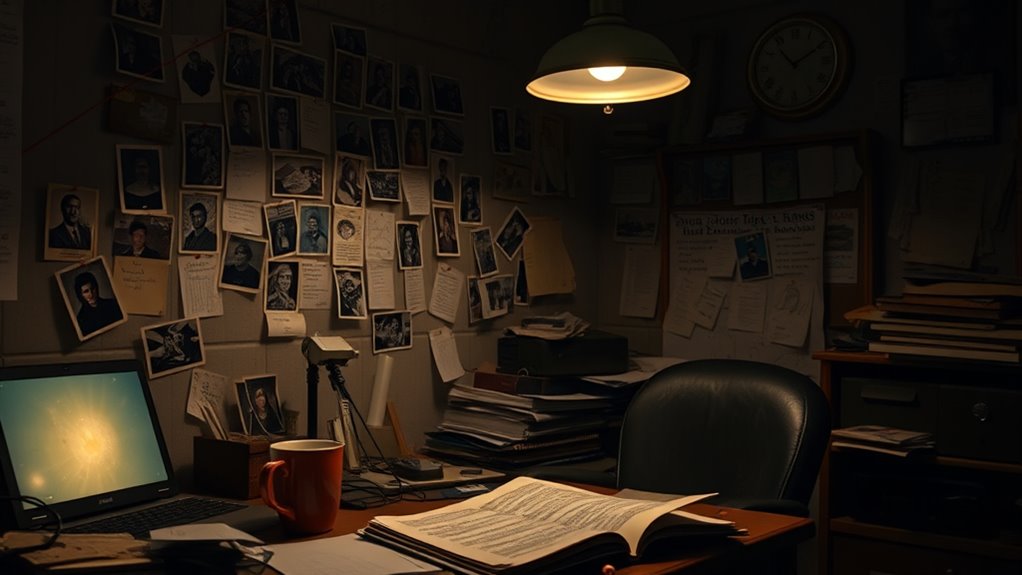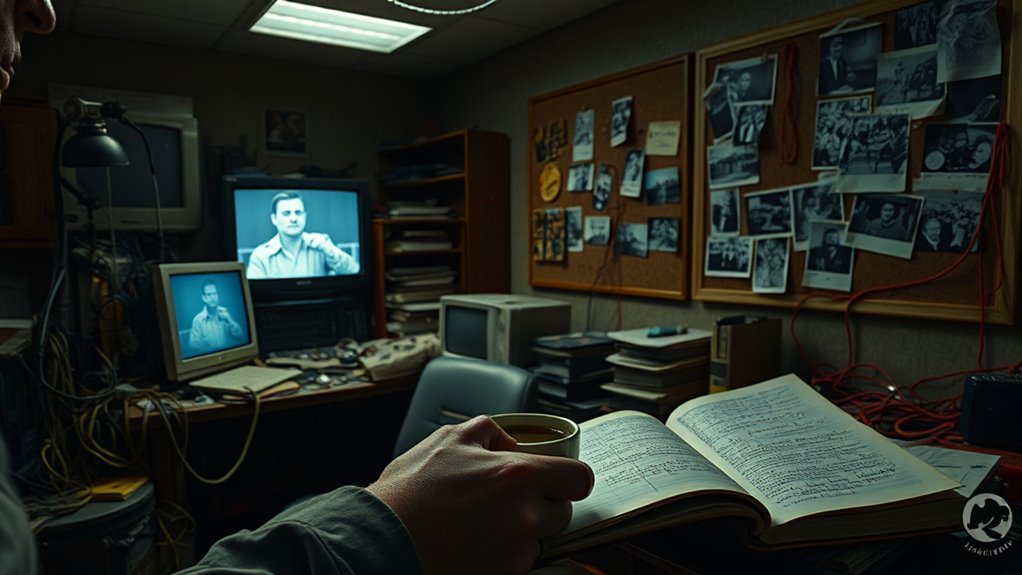Behind the scenes of an investigation, you don’t see the meticulous work involved in collecting, preserving, and analyzing evidence with precision to prevent contamination. Forensic experts use DNA tests, fingerprint analysis, and digital tools in specialized labs far from the spotlight. Investigators also spend countless hours interviewing witnesses, interpreting body language, and cross-referencing facts with forensic data. If you want to uncover what really happens beyond the TV scenes, there’s more to explore.
Key Takeaways
- Evidence collection requires meticulous techniques to prevent contamination and ensure court admissibility.
- Forensic analysis is conducted in specialized labs away from public view, emphasizing accuracy and integrity.
- Investigators follow strict procedures and legal guidelines to maintain data integrity and support justice.
- Behind the scenes involves long hours of data analysis, documentation, and careful handling of evidence.
- Effective investigations combine forensic science with psychological interview skills to uncover hidden truths.

When you think about investigations, you might imagine dramatic courtroom scenes or high-stakes arrests, but behind the scenes, it’s a meticulous process that requires careful planning and relentless effort. One of the most pivotal aspects of this work involves the use of forensic techniques. These methods aren’t as glamorous as what you see on TV, but they’re the backbone of solving crimes. You might not realize how much science goes into analyzing evidence—whether it’s fingerprint analysis, DNA testing, ballistics, or digital forensics. Each piece of evidence must be collected, preserved, and examined with precision to avoid contamination or mistakes that could compromise the case. Forensic experts work tirelessly behind the scenes, often in specialized labs far removed from the public eye, to uncover details that might seem small but can make or break an investigation. Accurate evidence handling is critical to ensure the integrity of the case and the admissibility of forensic data in court. Proper sample preservation techniques are essential to maintain the quality and reliability of forensic analysis throughout the investigation process.
Alongside forensic techniques, interview tactics play a vital role. When you’re conducting interviews, it’s not just about asking questions; it’s about skillfully drawing out information that isn’t immediately obvious. Investigators know how to establish rapport, read body language, and listen carefully for inconsistencies in a suspect’s story. These interview tactics require a keen sense of psychology and patience. Sometimes, it’s necessary to ask questions in a way that encourages openness, while other times, you need to be more direct to catch lies or hesitations. The best investigators know that what isn’t said can be as revealing as what is, and they’re trained to pick up on subtle cues that suggest deception or truth.
Effective interviews uncover hidden truths through rapport, body language, and subtle cues, making psychological insight essential for investigators.
Behind the scenes, these interview tactics are often refined through experience and training, and they’re integrated with forensic evidence to build a stronger case. For example, a suspect’s inconsistent story might be cross-referenced with forensic data or witness statements, creating a web of corroborating details. It’s a constant balancing act—analyzing physical evidence while interpreting human behavior. This combination of science and psychology is what makes investigations both challenging and rewarding, even if it doesn’t make for the dramatic TV moments. Additionally, understanding legal guidelines and proper evidence handling is crucial to ensure that all collected data is admissible in court, which requires investigators to be well-versed in investigation procedures.
In the end, what you see on TV is only a fraction of the effort involved. Behind the scenes, investigators work long hours, meticulously analyzing evidence and employing sophisticated interview tactics, all to uncover the truth. It’s a process driven by precision, patience, and a relentless pursuit of justice—far from the instant gratification portrayed in fictional dramas.
Frequently Asked Questions
How Do Investigators Choose Which Cases to Pursue?
When deciding which cases to pursue, you rely on case prioritization and investigative criteria. You assess the severity, evidence strength, and potential impact to determine if a case warrants attention. Factors like resource availability and urgency also play a role. By carefully evaluating these elements, you guarantee that your efforts focus on cases with the highest likelihood of success and the most significant importance, maximizing your investigative effectiveness.
What Tools Do Investigators Use That Aren’T Shown on TV?
While TV often highlights dramatic moments, investigators rely on tools like advanced surveillance techniques and forensic analysis you rarely see. These methods help gather vital evidence discreetly, ensuring accuracy and integrity in cases. Surveillance techniques involve subtle monitoring, and forensic analysis meticulously examines evidence in labs. Together, they form the backbone of effective investigations, working behind the scenes to uncover truths without the spectacle, keeping the process focused and precise.
How Do Investigators Handle False Leads?
When dealing with false leads, you rely on forensic analysis and witness interviews to verify information. You carefully re-examine evidence and cross-check details from witnesses to identify inconsistencies. You stay objective, avoiding assumptions, and follow the facts wherever they lead. By methodically ruling out false leads, you guarantee the investigation stays focused on genuine clues, increasing the chances of solving the case accurately and efficiently.
What Is the Most Challenging Part of an Investigation?
The most challenging part of an investigation is often sifting through false leads and staying focused. You rely heavily on forensic analysis to verify evidence and interview techniques to uncover truths. Staying objective and persistent amid uncertainty tests your patience and skills. Visualize the process like piecing together a puzzle, where every clue matters. Your ability to adapt and analyze critically makes or breaks the success of the investigation.
How Do Investigators Protect Their Identities?
You protect your identity by using undercover tactics, such as adopting a false persona and avoiding revealing personal details. Digital surveillance helps monitor threats and track any attempts to uncover you. You stay cautious online, employ secure communication channels, and limit the information you share. These methods guarantee your safety, allowing you to gather intel effectively without risking exposure. Your vigilance keeps your identity safe during sensitive investigations.
Conclusion
Now that you’ve peeked behind the curtain, you realize the investigation world is a chaotic whirlwind of secrets, lies, and adrenaline-fueled moments. What you see on TV is just the tip of the iceberg—beneath the surface, it’s a high-stakes, sleepless battle where every second counts. The real truth? It’s more intense, more unpredictable, and more jaw-dropping than you could ever imagine. Buckle up, because behind the scenes is where the real action happens.









